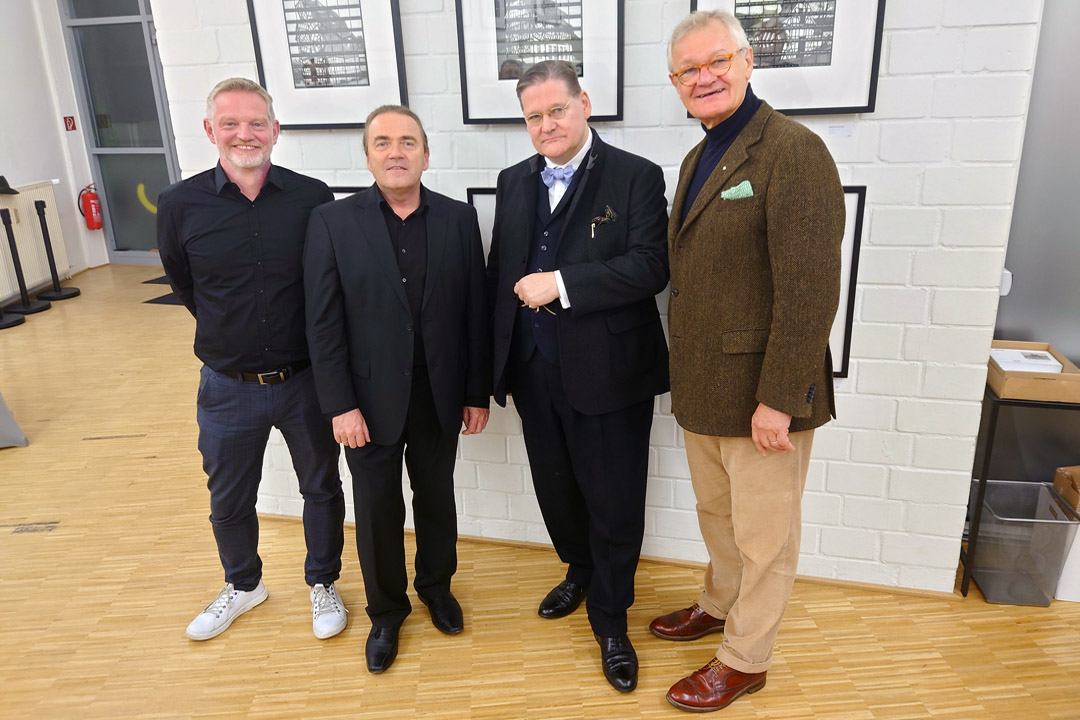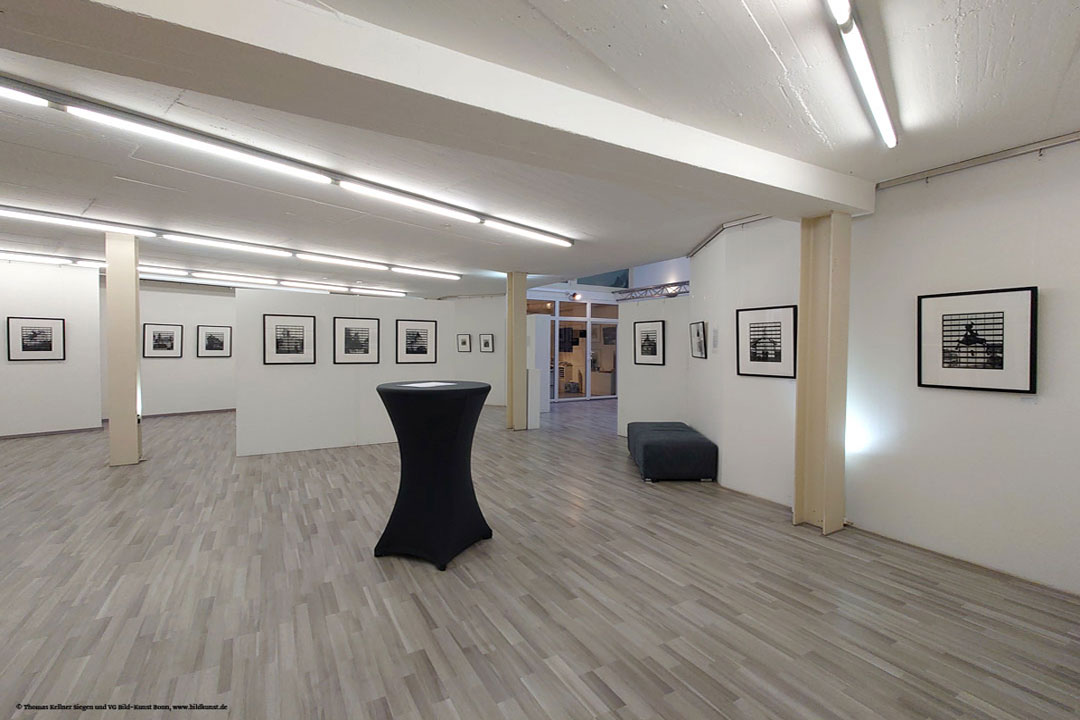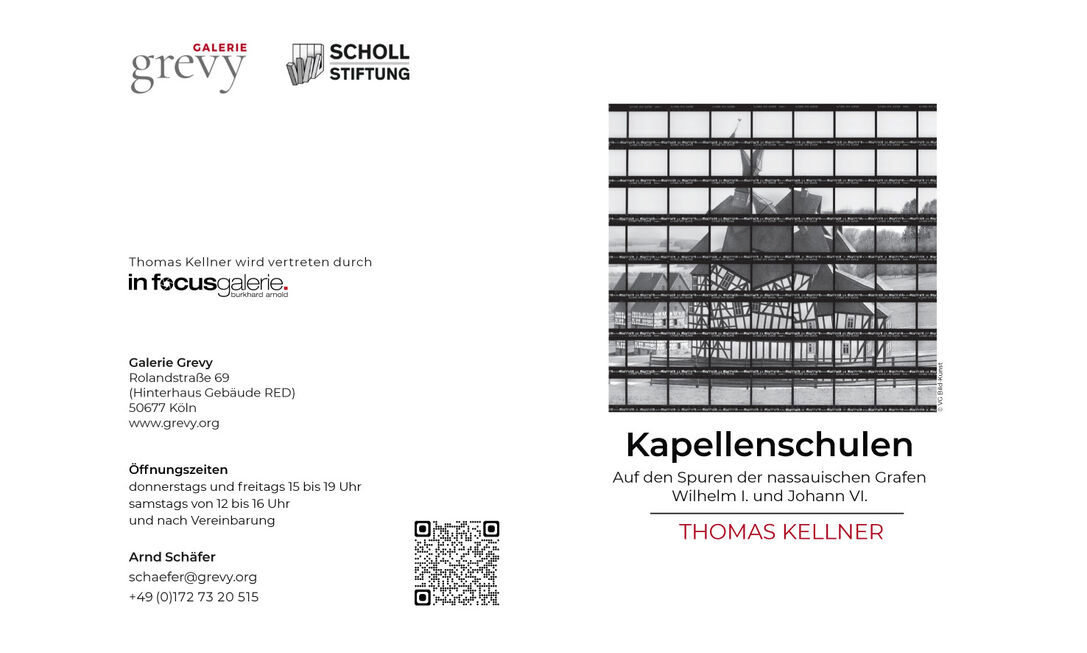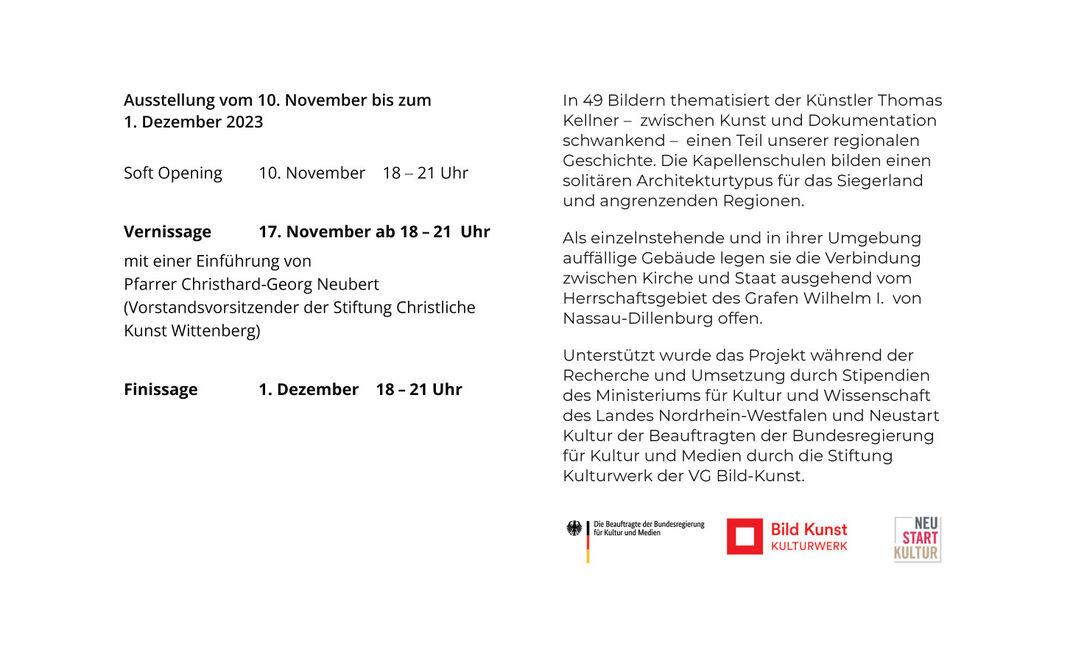Galerie Grevy, Cologne, in the Südstadt is a gallery and art community.

Scholl Foundation in November 2023 as a guest with Thomas Kellner from infocus Galerie at Galerie Grevy in Cologne's Südstadt district, the gallery and art community.

Cologne. From November 10 to December 1, the Scholl Foundation is showing the exhibition Chapel Schools by German photo artist Thomas Kellner (born 1966 in Bonn) at the Grevy Gallery. The project about the chapel schools, which have been erroneously reduced to the term Siegerland chapel schools, deals with this unique type of architecture, which combines the profane and sacred, religious and educational in one building. The chapel schools were initiated from 1532 in the territory of Nassau under William I and then John VI and were mainly built in the rural areas of present-day Siegen-Wittgenstein, the Westerwald and central Hesse.
During the pandemic, the photo artist developed ideas for working in the immediate vicinity of his home, as traveling would not be possible for the foreseeable future. In fact, four years passed between the last flight in 2019 and the first international trip in 2023. Part 1 of the trilogy about home was dedicated to the half-timbered houses on which Bernhard and Hilla Becher developed their typology and became world-famous. In the current second part of the trilogy, Kellner presents a further architectural part in his familiar visual language of contact arches. He is currently working on part of the trilogy, which is dedicated entirely to the people of the city, stylistically similar to his half-timbered houses.
In 49 pictures, the artist Thomas Kellner focuses on a part of our regional history that oscillates between art and documentation. The chapel schools form a solitary building type for the Siegerland and the neighboring regions. Standing alone and conspicuous in their surroundings, they illustrate the connection between church and state, based on the domain of Count Wilhelm von Nassau-Dillenburg (* April 10, 1487 in Dillenburg; † October 6, 1559 ibid.).
After Kellner had already devoted himself to Siegen's industrial culture in the form of industrial architecture in his Genius Loci series of works and explored the half-timbered houses of the Siegen industrial area in the footsteps of Bernd and Hilla Becher, the chapel schools complement his artistic exploration of the regional architectural landscape. The chapel schools were realized in Kellner's typical cubist-deconstructive style, which was described by Prof. Dr. Irina Chmyreva as "Visual Analytical Synthesis" or by Prof. Dr. Rolf Sachsse as "Modern Mannerism" and sets the motif visually in motion.
The Nassau Chapel Schools at Grevy Gallery


The chapel schools form a solitary type of architecture that reveals the connection between religion and school education. As a result, religious services and school lessons are combined in one building, which classifies the chapel schools as hybrid buildings. The term chapel school resulted from the partial integration of the schools into existing chapels and has become established, particularly in the Siegerland and neighboring areas, as a result of geographical and political connections. The artistic examination of the chapel schools aims to preserve and recall this cultural asset typical of the region through a new medium. Last but not least, historical ignorance and a lack of interest led to the sale, demolition or conversion of a large number of dilapidated chapel schools in the post-war period. In 49 motifs, Thoms Kellner therefore devotes himself to a regional and cultural-historical theme: the chapel schools.
The architectural appearance
The hybrid use of the chapel schools is architecturally anchored and is reflected in a building type that oscillates between profane and sacred. The external appearance of the Kappelen schools is not linked to religion and does not reveal the denominational affiliation either through the façade design or building construction or through the room layout. The buildings are primarily characterized by their functional design. The only indications of religious use are a ridge turret with a bell and, in places, a five-fifths closure of the choir, as well as the interior design, which allows conclusions to be drawn about the denomination, at least in the interior. In addition to its educational and religious use, the chapel school was a multifunctional place for the community, which continues to this day. It was precisely the proximity of the chapel schools to bourgeois residential buildings that facilitated a detachment from the religious context and enabled a change of use after the buildings had become too small for school lessons.
William I and John VI
Count William I, known as the Rich, and his son John VI, known as the Elder, are regarded as the initiators of the chapel schools. William, who had witnessed Luther's failure to recant his theses and writings at the Diet of Worms in 1521, paved the way for the Reformed faith in his dominion. While he introduced measures against the sale of indulgences as early as 1518, it was not until the introduction of the Brandenburg-Nuremberg Church Order in 1534 that the Lutheran Reformation was brought about in the county. In 1578, his son John VI introduced the Reformed confession in Nassau-Dillenburg and Nassau-Siegen. During his reign, faith and education became particularly important, so that he is regarded as a patron of schools and, from 1567, of chapel schools. The resulting nationwide establishment of schools with lessons for boys and girls as well as the increasing standardization of teaching was part and parcel of literacy.
The role of faith
When the Reformed confession was introduced in Nassau-Dillenburg and Nassau-Siegen under John VI in 1578, the population was faced with a second change of confession within 44 years. Parts of the population were critical of the new rite associated with it, but the change was basically in agreement with the Siegen town council. This was not only a supporter, but also the initiator of the conversion to the Reformed faith. The change of confession was the trigger for an educational offensive on the part of John VI, the aim of which was to bring the theology of the catechism and the Reformed faith to the population through education. Boys and girls were taught to read and write in chapel schools, undoubtedly on the basis of the catechism. From 1624, John VIII attempted to re-Catholicize the hereditary lands. He was only successful in Netphen and parts of the town of Siegen.
Kellner's chapel schools
By transferring the cultural heritage of the chapel school into an artistic framework through the medium of photography, Thomas Kellner gives this in many respects historical subject a new dimension in contemporary art. Technically, he draws on the elementary structures of the architecture of the chapel schools and their hybrid use, embodied by religion and school education. The grid of contact arches used by Kellner can be found in the open framework or the slate cladding of the façades, the various tilting moments in the picture are in line with the multifunctional use of the spaces, and the multi-perspective realization reflects above all the interrelationship between religious and scholastic use. The view of the past only ever works from a present perspective. Kellner uses his photographic-artistic position for this and knows how to rethink the view of the chapel schools while remaining true to his own artistic past.
Thomas Kellner - Chapel schools. In the footsteps of the Nassau Counts Wilhelm I and Johann VI.
13.11.2022 – 11.2.2023 Artgalerie, Siegen
10.11. –01.12.2023 Galerie Grevy, Cologne
18.01.–23.02.2024 Kunst für Chemnitz e. V.
Scholl Foundation cooperates with the Grevy Gallery
The Scholl Foundation has set itself the task of cultivating and honoring the work of the Cologne artist and founder Rudolf A. Scholl (died 2018) and making it accessible to the public, as well as promoting the visual arts and music in general through exhibitions, readings, lectures and concerts, thereby offering a space for interdisciplinary, artistic dialogue. The Scholl Foundation also cultivates and promotes the works and projects of the composer Michael Gregor Scholl, son of the founder - whose current work Caprices en noir. Fantastic Reflections on Alfred Kubin will be premiered on January 6, 2024 at the Konzerthaus Berlin am Gendarmenmarkt. The Scholl Foundation aims to promote and expand institutional cooperation and exchange in the cultural field through joint projects with, for example, the AntoniterCityKirche and Greven Verlag and the permanent cooperation with the Cologne gallery Grevy, which has been in place since 2022.
Thomas Kellner, artist at Galerie Grevy
Thomas Kellner was born in Bonn in 1966. He studied art, sociology, politics and economics at the University of Siegen. In 1996, he received the Kodak Young Talent Award for his series of pinhole camera photographs Deutschland - Blick nach draußen, which encouraged him to pursue a life as a photographic artist. Since then, Kellner has lived and worked as an artist and curator of photographic exhibition projects in the Siegerland region. Since 1993, Kellner has shown his work in solo exhibitions worldwide, including four solo exhibitions in New York and in Germany, Australia, England, Russia, China, France, Iceland, Poland, Denmark, Brazil, Syria, Spain and the USA, among others, and has participated in numerous group exhibitions and publications. His works are represented in important private and public collections such as the Art Institute of Chicago, the Museum of Fine Arts in Houston, the Museu de Arte Moderna in Rio de Janeiro, the Baltimore Museum of Art, the Fox Talbot Museum in Lacock Abbey and the George Eastman Museum in Rochester. In 2003 he was appointed to the German Society for Photography (DGPh).
Gallery Grevy
Founder Arnd Schäfer of Galerie Grevy, a gallery and art community, describes how the gallery has become a major player in the art scene. Starting in 2010, conversations with artists sparked a dedication to art that opened up a new world for the founder. Originally launched in 2014 as an online platform for art, Grevy was intended to offer artists and galleries the opportunity to present themselves together and thus gain more visibility, similar to the Artsy platform. This initiative evolved into a physical art space called Grevy in 2018, which initially hosted 18 artists. In 2019, Grevy transformed more and more from a platform to a gallery, and since 2023, the institution can claim not only the name but also the vibrancy of a contemporary art gallery.
The Grevy Gallery represents around 50 artists. The gallery program includes 10 to 12 exhibitions per year, with 1 to 2 fair appearances per year since 2023. These figures illustrate the commitment and diversity that Grevy offers in the contemporary art scene.
According to Arnd Schäfer, the key to a gallery's success is quality and continuity. This extends not only to the quality of the art exhibited, but also to its presentation. The entirety of an exhibition, from the hanging to the advertising, communication, the chosen theme, the title and the preparation and follow-up, is seen as an independent element of the presentation. Galerie Grevy pays particular attention to storytelling in order to break viewing habits, generate attention and thus retain customers and attract new ones.
The Covid-19 pandemic has been a challenging time for cultural institutions, which the gallery has coped with well financially. In addition, the pandemic situation has led to new forms of communication. One concrete example of this is the "nine studios", virtual studio visits that were introduced. Streaming, videos and YouTube were also used as tools to make art tangible despite physical distancing. Last but not least, the use of QR codes proved successful for the gallery.
These adjustments to the communication strategy illustrate the gallery's ability to respond flexibly to the challenges of the pandemic while finding innovative ways to reach and engage art lovers.
The energy crisis and inflation of recent months have been particularly challenging for the gallery. These two factors had a significant financial impact, as they led to a general reluctance to buy on the part of customers on the one hand and increased the costs of running the gallery on the other. This double burden posed a serious financial challenge.
However, the good news is that the situation is now slowly beginning to ease. This could indicate that the gallery has developed successful strategies to deal with these economic uncertainties and adapt to changing conditions. The ability to respond flexibly to various crises while maintaining financial stability is testament to the gallery owner's resilience and business acumen.
The gallery relies neither exclusively on traditional exhibition concepts nor exclusively on an online presence, but constantly considers both. Galerie Grevy started as an online platform with an online store, blog and social media presence. To further strengthen its online presence, the gallery is seeking partnerships with established platforms such as Kooness and Artsy.
The gallery owner acknowledged the significant influence of the internet and social media on viewing habits, communication and purchasing habits. Instead of denying this, the gallery is constantly working to adapt and take advantage of the opportunities offered by this development. Personal contact with artists and art remains of central importance. In this context, the traditional role of the gallery owner is shifting towards that of a mediator between customer and artist, a host, moderator and link. The traditional role of the gallery owner to secure contacts seems less timely in the fast pace of a digital age.
In addition to pure exhibitions, there are also events in the gallery to entertain visitors. These events range from readings and artist talks to lectures and occasionally music, depending on the art, the theme, the artist and the season. This variety of activities demonstrates the gallery's desire to offer visitors a holistic cultural experience and to bring art to life in different ways.
Artists are selected solely on the basis of their personal enthusiasm for their art. Only through this enthusiasm can a message be credibly conveyed to the outside world. The gallery is now able to select from the weekly requests from artists. The Grevy Gallery also likes to visit open studios and exhibitions and uses the Internet to keep an eye out for new talent. This often results in exhibition ideas.
For Galerie Grevy, artists who pursue a concept over a longer period of time, get to the heart of it and develop their own signature style are particularly appealing. Art must fascinate and move, whether on an intellectual or emotional level.
Thomas Kellner and the Grevy Gallery met two years ago through the Scholl Foundation. The chemistry was right from the start and the gallery was immediately enthusiastic about the works and is particularly pleased to be working with him. This positive assessment shows how important personal connections and a deep understanding of an artist's art are for the gallery.
Gallery Owner Arnd Schaefer of Gallery Grevy
Arnd Schäfer, a gallery owner with a varied past, provides insights into his early years and his career before becoming a gallery owner.
Arnd Schäfer was born and grew up in Remscheid Lennep in the Bergisches Land, a town characterized by half-timbered houses and a rather tranquil charm. His curiosity and enthusiasm for science and mathematics became apparent at school at an early age. The variety and the possibility of being able to understand everything sparked his interest in becoming an astronaut - a dream motivated by the desire for constant discovery and exploration.
In Lennep, where cultural opportunities were limited, Schäfer's quest for knowledge and experience began to manifest itself at a young age. However, his professional goals as a child were to differ from his later career.
After leaving school, Arnd Schäfer studied economics with a focus on corporate finance and finance. Economics, which combines business administration and economics, offers a holistic perspective on companies and society. The financial markets fascinated him, and economics became another means of understanding the world of people and their society. Questions about the prosperity of states, the success of companies and the functioning of markets drove his research.
Arnd Schäfer's professional journey took him into investment banking, where he worked as a macroeconomist. In this position, he dealt with the overarching economic contexts and expanded his understanding of how global financial markets work.
The curiosity and quest for understanding that had driven him as a child found expression in economics and investment banking. But as it turned out, this was just one chapter in Arnd Schäfer's impressive career before he finally entered the art world as a gallery owner.
Arnd Schäfer's journey into the world of art began through a personal connection. His ex-husband, a graduate of the Düsseldorf Art Academy, introduced him to the fascinating world of artists.
The discrepancy between Schäfer's economic world and the thoughts of the artists aroused his interest and amazement. The discovery of how differently people from different fields could think added a new layer to his previous interests. Alongside his affinity for science and economics, art opened up an exciting and fascinating dimension.
This personal insight and the encounter with artists' creative ways of thinking laid the foundation for Arnd Schäfer's path into the art world. This experience not only shaped his perspective, but also paved the way for his later role as a gallery owner, in which he was able to combine his passion for art with his broad expertise.
The decision to open a gallery in Cologne was the result of Arnd Schäfer's unpredictable life path and his talent for recognizing and taking advantage of open doors and opportunities. The founding of the gallery was not the result of meticulous planning for the future, but a result of circumstances and his willingness to embrace change.
After the bank he worked for went under in the 2010 banking crisis, the desire arose to do something completely new. After some coaching, Schäfer decided to switch to project management and completed a corresponding training course. Projects that always involve something new fascinated him more than processes that deal with optimizing the same old thing. Planning, creativity and communication skills are crucial for successful project management - precisely his strengths. His creative streak and his enjoyment of contact with people sometimes made him too unconventional in his banking job.
The first project Schäfer initiated was the online platform "Grevy" for artists. He enjoyed this idea so much that he decided to stick with it. The ambition to have his own exhibition space was inspired by the artists. When the opportunity arose to rent the current space, Schäfer asked his then 30 artists if they would support him. 18 of them immediately agreed, and so the art space was created, originally planned for just 18 months. This development shows how Arnd Schäfer spontaneously seizes opportunities and relies on support and collaboration with artists.
As a gallery owner, Arnd Schäfer faces a variety of challenges and his day-to-day work is characterized by a wide range of tasks, from planning exhibitions to advising artists and start-ups.
There is hardly a typical day for him, as his field of work is extremely varied. He sees each exhibition as a new project involving different artists and themes. Arnd Schäfer often works on 3-4 exhibitions at the same time, which are in different phases. His field of activity ranges from brainstorming to planning and implementation, and he is involved in all aspects. Networking with cooperation partners and artists is also an important part of his daily tasks.
As a gallery owner and consultant in the art sector, Arnd Schäfer is also active outside his gallery. His advice to photographers and collectors focuses on various aspects. In the art sector, the emphasis is on the professionalization of artists, including aspects such as web presence, social media, flyers and publications. He advises on current trends, calls for proposals, funding opportunities, and also on topics such as NFTs (non-fungible tokens). The variety of questions that artists come to him with is reflected in his wide-ranging answers and his network, enabling him to provide expert help with specific issues.
Arnd Schäfer is actively involved in various areas and works with different networks and organizations, which is an important part of his role as a gallery owner.
The gallery has repeatedly taken part in Photoszene, an event at which the internationally renowned photographer Herlinde Koelbl was presented this year, which was a great success. The Scholl Foundation is a long-standing cooperation partner with whom the gallery works on an ongoing basis. Further partnerships and collaborations exist or have existed with Instant Cologne, the PAN Museum in Emmerich, Kunstnavigation in Bonn, the project "THE ADAHAN EXPEDITION" between Cologne and Istanbul and other cultural events in Cologne and Cologne's Südstadt district.
Gallery owner Arnd Schäfer highlights two situations as defining moments in his career. He counts the meeting and collaboration with the renowned photographer Herlinde Koelbl in 2023 as a great honor and formative event. Getting to know her personally and the exhibition in his gallery created not only artistic but also personal connections. Another formative situation is the feedback from his artists. Despite turbulent years due to events such as the coronavirus pandemic and the energy crisis, Arnd Schäfer has received strong support and positive feedback from his artists. The original community idea he pursued with Grevy continues to sustain the gallery and strengthen it for the future.
Art has a huge impact on the life of gallery owner Arnd Schäfer, who is surrounded by art and artists. He finds this very enriching and has no regrets about changing his profession.
In his free time, Arnd Schäfer enjoys going for walks and has a passion for audio books. Spending time with his husband, family and friends is particularly important to him and they meet up regularly. To relax, he likes to watch documentaries from the media libraries of ARTE and similar channels. These activities provide him with a balance to his intensive work as a gallery owner at Galerie Grevy and allow him to immerse himself in other areas of interest.
Thomas Kellner - Chapel schools at Galerie Grevy
Thomas Kellner - Chapel schools. In the footsteps of the Nassau Counts Wilhelm I and Johann VI.
November 10 till December 1, 2023
Galerie Grevy, Cologne, Germany
Galerie Grevy
Rolandstrasse 69
50677 Cologne
Opening hours
Thu. & Fri. 3 to 7 p.m.
Sat. 12 to 4 p.m.
info@grevy.org
+49 221 16539580
www.grevy.org
Scholl Stiftung
Friesenwall 96–98
50672 Cologne
Germany








